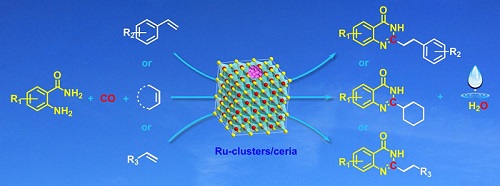Shedding insights into the acid-base properties at the atomic level is crucial for heterogeneous catalysis. How to detect and identify the geometric structure, exact position and the acid-base properties of active sites remains a tremendous challenge in heterogeneous catalysis.
A research group led by Prof. WANG Feng found that the interfacial Lewis acid-base pair, which consisted of acidic Ce-Vo site and basic interfacial oxygen of Ru-O-Ce linkage, readily formed on the Ru-clusters/ceria.
Based on this discovery, the concept "Interfacial Acid-Base Pair" was mentioned for the first time (J. Am. Chem. Soc.). Recently, the scientists found that the quinazolinones could be synthesized from olefins, CO and amines over heterogeneous Ru-clusters/ceria catalyst, forming three new bonds including C-C, C-N and C=N. Their findings were selected as "hot Paper" and published in Angew. Chem. Int. Ed..

The synthesis of quinazolinones from olefins, CO, and amines over a heterogeneous Ru-clusters/ceria catalyst. (Image by AN Jinghua)
The mechanism research showed that amide species formed during the reaction was verified to be the reaction intermediate. And then the target product quinazolinone was easily obtained via the dehydration of intermediate amide, which could be catalyzed by acid sites on ceria support. The quinazolinone could be obtained in 99% isolated yield under optimized conditions.
The generation of intermediate amide species needs an acidic conditions. However, the amine, acts as a basic molecule, inhibits the generation of amide species. In this work, the scientists overcame this problem by forming Brosted acid in situ via the activation of amine on the interfacial acid-base pair of Ru-clusters/ceria.
This study provides an economical and sustainable route for the synthesis of quinazolinones, extending the application of the concept "Interfacial Acid-Base Pair".
This work was supported by Strategic Priority Research Program of the Chinese Academy of Sciences and the National Natural Science Foundation of China. (Text by AN Jinghua)